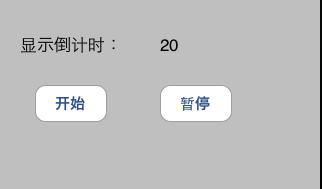NSTimer 详细设置
先说一下我的业务需求,最近在做一个小项目,需要用到定时器的功能,NSTimer类,期间,出现了一些小问题,不过最终通过自己的努力,终于做出来了。我想总结一下,我对NSTimer类的学习和理解。
不多说了,先上效果图

界面元素很简单,两个UIButton 开始和暂停,20表示起始倒计时。最终的效果是,按开始按钮的时候,倒计时开始运行,按暂停按钮的时候,计时器,停止倒计时。当倒计时为0的时候,弹出一个对话框,提示时间已到。
业务需求很简单,但是,在我的实现中,却出现了,一些小错误。 主要是暂停键不能点击多次,开始键也不能点击多次,我相信,刚开始,接触这个NSTimer的人,也会出现这几个问题。
直接上几个主要的代码:
控制器类的.h文件中
@interface sdsViewController : UIViewController<UIAlertViewDelegate>
//定义一个定时器,做为实例变量
@property(nonatomic,retain) NSTimer *timer;
//显示倒计时当前状态
@property (retain, nonatomic) IBOutlet UILabel *timeDisplay;
//开始按钮,响应的action
- (IBAction)startTime:(id)sender;
//暂停按钮响应的action
- (IBAction)stopTime:(id)sender;
@end
.m中关键代码
开始按钮 响应代码:
- (IBAction)startTime:(id)sender {
//如果定时器对象不存在,则创建一个并启动
if(!_timer){
//创建一个定时器,这个是直接加到当前消息循环中,注意与其他初始化方法的区别
_timer=[NSTimer scheduledTimerWithTimeInterval:1.0 target:self selector:@selector(changeTimeAtTimedisplay) userInfo:nil repeats:YES];
// [_timer fire]; //对于这个fire方法,稍后会详解,它不是启动一个定时器,这么简单
}
}
//结束按钮响应代码:
- (IBAction)stopTime:(id)sender {
if (_timer) {
NSLog(@"调用 self.time为真!!");
//如果定时器在运行
if ([self.timer isValid]) {
NSLog(@"单击停止按钮,取消定时器!!");
[self.timer invalidate];
//这行代码很关键
_timer=nil;
}
}
}
一切OK,现在分析程序用到的关键地方。
先看看NSTimer类的结构,比较简单
Tasks
Creating a Timer
//创建一个定时器 ,以下是便利构造器方法,都懂的
+ scheduledTimerWithTimeInterval:invocation:repeats:
+ scheduledTimerWithTimeInterval:target:selector:userInfo:repeats:
+ timerWithTimeInterval:invocation:repeats:
+ timerWithTimeInterval:target:selector:userInfo:repeats:
//初始化方法
– initWithFireDate:interval:target:selector:userInfo:repeats:
//是开始一个定时器吗,恐怕没那么简单????????
Firing a Timer
– fire
//是暂停一个定时器吗,NO ,是Stop ,写的很清楚
Stopping a Timer
– invalidate
//关于定时器的以下信息
Information About a Timer
– isValid //是否在运行
– fireDate //Returns the date at which the receiver will fire.
– setFireDate: //重新设置定时器开始运行的时间
– timeInterval //定时器延时时间
– userInfo //其他信息
先说一下,初始化方法
+ scheduledTimerWithTimeInterval:invocation:repeats:
+ scheduledTimerWithTimeInterval:target:selector:userInfo:repeats:
这两个是创建一个定时器,并加入到当前运行循环中,即我们可以这样去理解,这样初始化一个定时器时,在(NSTimeInterval)seconds 时间之后,自动启动定时器。
而以下两个初始化方法这不一样:
+ timerWithTimeInterval:invocation:repeats:
+ timerWithTimeInterval:target:selector:userInfo:repeats:
这 两个同样是创建,但没有加入到,运行循环中。class method to create the timer object without scheduling it on a run loop.然后,建立之后,必须(after creating it, you must add the timer to a run loop manually by calling the addTimer:forMode: method of the corresponding NSRunLoop object.),这就是与上面两个方法的区别。
//创建一个定时器
_timer=[NSTimer scheduledTimerWithTimeInterval:1.0 target:self selector:@selector(changeTimeAtTimedisplay) userInfo:nil repeats:YES];
_timer=[NSTimer timerWithTimeInterval:10 target:self selector:@selector(changeTimeAtTimedisplay) userInfo:nil repeats:YES];
//必须手动加入到当前循环中去
NSRunLoop *runloop=[NSRunLoop currentRunLoop];
[runloop addTimer:_timer forMode:NSDefaultRunLoopMode];
以上两端代码效果是一样的
关于这个方法:
Firing a Timer
– fire
其实他并不是真的启动一个定时器,从之前的初始化方法中我们也可以看到,建立的时候,在适当的时间,定时器就会自动启动。那这个方法是干什么的呢。
You can use this method to fire a repeating timer without interrupting its regular firing schedule. If the timer is non-repeating, it is automatically invalidated after firing, even if its scheduled fire date has not arrived.
这是官方文档的说法,英文说的很清楚,但我们理解还不是很到位,为了彻底搞懂它的功能。我又做了一个测试。
也是很简单,把上面那个定时器,改变一点
//初始化的时候创建一个定时器
- (id) initWithNibName:(NSString *)nibNameOrNil bundle:(NSBundle *)nibBundleOrNil{
self = [super initWithNibName:nibNameOrNil bundle:nibBundleOrNil];
if (self) {
// Custom initialization
//创建一个定时器,
_timer=[NSTimer timerWithTimeInterval:10 target:self selector:@selector(changeTimeAtTimedisplay) userInfo:nil repeats:YES];
//手动加入到循环中
NSRunLoop *runloop=[NSRunLoop currentRunLoop];
[runloop addTimer:_timer forMode:NSDefaultRunLoopMode];
//当然这个定时器会自动启动,只不多过了十秒之后,才触发
}
return self
}
当我们单击“开始”按钮时,
- (IBAction)startTime:(id)sender {
//只是简单地调用一下这个方法,看到底功能是什么
[_timer fire];
}
结 果是,单击一下按钮,倒计时减1,单击一下减1,即它把触发的时间给提前了,但过十秒后倒计时还会减1,即它只是提前触发定时器,而不影响之前的那个定时 器设置的时间,就好比我们等不及要去看一场球赛,赶紧把车开快些一样,fire的功能就像让我们快些到球场,但却不影响球赛开始的时间。
还 记得之前那个初始化定时器时,设置的是YES吗,当我们,改为NO时,即不让它循环触发时,我们此时再单击开始按钮。会猛然发现,倒计时减1了,但当我们 再点击开始按钮时,会发现倒计时,不会动了。原因是:我们的定时器,被设置成只触发一次,再fire的时候,触发一次,该定时器,就被自动销毁了,以后再 fire也不会触发了。
现在 我们再看官方的解释,或许就会更明白了,
You can use this method to fire a repeating timer without interrupting its regular firing schedule. If the timer is non-repeating, it is automatically invalidated after firing, even if its scheduled fire date has not arrived.
这就对了,fire并不是启动一个定时器,只是提前触发而已。